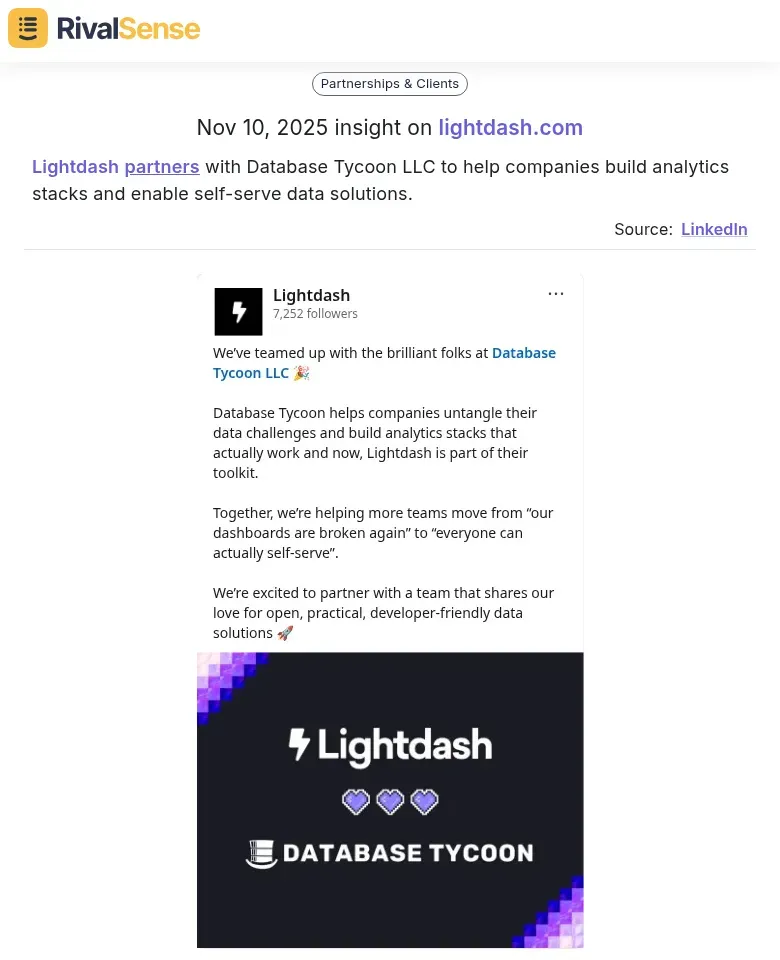How Competitors Countered Lightdash's Strategic Partnership
In the dynamic B2B analytics sector, strategic partnerships can swiftly alter competitive landscapes, forcing businesses to adapt or lose market share. When Lightdash announced a key alliance, it triggered immediate responses from rivals, highlighting the need for proactive monitoring. This post delves into how competitors countered Lightdash's move and offers practical advice for staying ahead.
The Game-Changing Partnership
Partnerships often serve as catalysts for market disruption, enabling companies to expand capabilities and reach overnight. Lightdash's collaboration with Database Tycoon LLC exemplifies this, helping firms build analytics stacks and self-serve data solutions seamlessly.

Tracking partnership insights like this is invaluable for business strategy, as it reveals competitors' expansion plans, technological enhancements, and potential threats to your market position. By analyzing such moves early, you can identify gaps in your own offerings and prepare counter-strategies.
Competitor Response Strategies
When Lightdash's partnership went live, competitors like Tableau and Power BI mobilized within days to protect their turf. They launched counter-partnerships, accelerated feature rollouts, and initiated aggressive marketing campaigns to retain customers and poach Lightdash's base.
Actionable steps to monitor and respond:
- 🔍 Set up alerts for competitor partnership announcements and product updates
- 📊 Analyze how alliances expand rivals' capabilities and market reach
- 💰 Track pricing changes and promotional offers post-announcement
- 🚀 Develop rapid-response protocols for feature launches or messaging shifts
Early detection allows you to anticipate moves and craft preemptive strategies, minimizing disruption to your business.
Monitoring and Intelligence with RivalSense
Tools like RivalSense provide real-time intelligence on competitor activities, from partnerships to pricing updates. For instance, RivalSense tracked Lightdash's moves and competitor reactions, delivering insights via weekly reports that highlighted emerging threats and opportunities.
Practical checklist for leveraging competitive intelligence:
- [ ] Monitor competitor websites and social media for announcement signals
- [ ] Analyze job postings for hints on new capability development
- [ ] Use comparative dashboards to identify strategic gaps
- [ ] Set up alerts for regulatory changes or management shifts
By implementing these steps, you can transform raw data into actionable plans, ensuring you're always prepared for market shifts.
Key Takeaways for Competitive Strategy
Lightdash's partnership underscores that in B2B markets, complacency can be costly. Continuous monitoring and agile responses are essential to defend and grow your market share. Learning from this case, businesses should prioritize intelligence-driven strategies to stay competitive.
Essential lessons:
- Partnerships as early warnings: They often signal a competitor's next big move, so analyze implications promptly.
- Proactive counter-planning: Maintain a response playbook for common competitive actions to enable swift execution.
- Architectural agility: Companies with modular systems adapt faster, gaining an edge over slower rivals.
Quick checklist for ongoing strategy:
- ✅ Review competitor alerts weekly
- ✅ Update response protocols quarterly
- ✅ Conduct scenario planning sessions monthly
Try RivalSense for Free
To effectively monitor competitor partnerships, pricing changes, and other critical moves, leverage RivalSense for comprehensive tracking. Get started today with a free trial at https://rivalsense.co/ and receive your first competitor report to tackle the challenges discussed in this post!
📚 Read more
👉 Facebook Competitor Insights Framework: Templates for Key Account Tracking
👉 How to Outsmart Vacation Rental Software Competitors with Feature Analysis
👉 Unlocking Growth Through Competitive Partnership Intelligence
👉 Leveraging Competitor Event Participation for Strategic Insights
